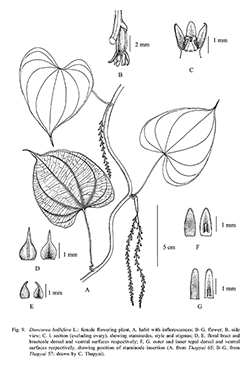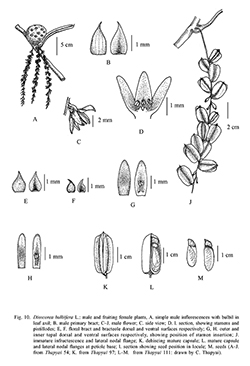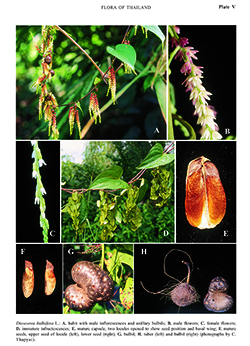e-Flora of Thailand
Volume 10 > Part 1 > Year 2009 > Page 23 > Dioscoreaceae > Dioscorea
5. Dioscorea bulbifera L.wfo-0000389411
Sp. Pl. 2: 1033. 1753; Blume, Enum. Pl. Javae. 1: 23. 1827; Craib, Bull. Misc. Inform. Kew 1912: 407. 1912; Prain & Burkill, J. & Proc. Asiat. Soc. Bengal 10:26. 1914; Bull, Misc. Inform. Kew 1919: 340. 1919; Ridl., Fl. Malay Penin. 4: 315. 1924; R.Knuth in Engl., Pflanzenr. 4, 43: 88, fig. 19F–L. 1924; Prain & Burkill, Bull. Misc. Inform. Kew 1927: 233. 1927; in Fl. Indo Chine 6: 728. 1934; Ann. Roy. Bot. Gard. (Calcutta) 14(1): 111. 1936; Burkill in Fl. Mal. 4, 3: 311. 1951; Hô, Câyco Viêtnam 3, 2: 939. 1993; Noltie in Fl. Bhutan 3(1): 9. 1994; Jayasuriya in Rev.Handb. Fl. Ceylon 9: 50. 1995; Ding & Gilbert in Fl. China 24: 288. 2000.— Helmia bulbifera (L.) Kunth, Enum. Pl. 5: 435. 1850.— Polynome bulbifera (L.) Salisb., Gen. Pl.: 12. 1866. Fig. 9, 10; Plate V.
Accepted Name : This is currently accepted.
Synonyms & Citations :
Description : Climber of variable habit to at least 25 m. Tubers solitary, ca 10–20 by 5–15 cm, variable in shape, usually globose to cylindric, sometimes digitate or irregularly lobed, shallowly buried, annually replaced, sometimes absent. Indumentum absent. Stems 15–20 mm in diam. toward base, twining to the left, annual, unarmed, terete but with a longitudinal groove in some herbarium specimens. Leaves simple, alternate, blade broadly ovate to orbicular, thinly chartaceous, 5–9(–11)-veined, margins entire or slightly undulate, base cordate, sometimes subcordate to rounded, apex acuminate; petioles 5–12 cm long, often with undulate margin; lateral nodal flanges present as a pair of membranous semicircular projections to ca 5 mm in diam. which clasp stem, margins sometimes erose; cataphylls absent; bulbils abundant, 0.2–12 cm in diam., usually globose to ovoid, sometimes cylindric, epidermis smooth to tuberculate or pitted. Inflorescences spicate, pendent, axes terete, flowers turned towards inflorescence apex; male inflorescences usually compound, 1–2 per axil, simple/partial inflorescences (1–)2–6(–12) per axil, peduncles 0.3–0.8 cm long, axes 2.5–8 cm long; female inflorescences simple, (1–)2–6 per axil. Male flower colour (often preserved in dried specimens) turning from green or pale green to white-yellow or cream, then purple to reddish-brown, outer tepals 1.4–2.8 by 0.5–1.1 mm, lanceolate to elliptic-oblong, inner tepals 1.4–2.8 by 0.4–0.7 mm, narrowly oblong to narrowly oblong-elliptic or lorate, stamens 6. Female flowers as Fig. 9B–G, Pl. 5C. Capsules as Fig. 10J–L, Pl. 5D, 25–50 by 10–12 mm. Seeds 3–5 by 2.3–4 mm, ovoid to ellipsoid with a small apical projection, wing extending from seed base, 12–16 by 5–6 mm, oblong to narrowly elliptic.
Thailand : NORTHERN: Mae Hong Son (Khun Yuam, Mae Su Rin), Chiang Mai (Doi Suthep-Pui, Doi Chiang Dao, Doi Inthanon, Hot, Mae Taeng, Ban Pha Mon, Chang Hua Lin, Mae Rim), Chiang Rai (Doi Luang), Lampang (Chae Son, Pha Thai Cave, Wang Nua), Phrae, Uttaradit (Phu Soi Dao, Ban Khok, Queen Sirikit Dam), Tak (Bhumibol Dam, Doi Musoe, Khao Pra Wa, Mae Sot, Umphang), Sukhothai (Kow), Phitsanulok (Thung Salaeng Luang, Phu Miang); NORTH-EASTERN: Phetchabun (Khao Kho, Thung Salaeng Luang), Loei (Wang Saphung, Dan Sai, Phu Kradueng, Phu Luang), Nong Khai (Phu Wua), Maha Sarakham (Phayakkhaphum Phisai), Kalasin (Kuchinarai), Khon Kaen; EASTERN: Chaiyaphum (Phu Khiao), Nakhon Ratchasima (Khao Yai, Lat Bua Khao), Buri Ram (Pasart), Roi Et (Phon Sai);SOUTH-WESTERN: Kanchanaburi (Thong Phaphum, Sangkha Buri, Sri Sawat), Phetchaburi (Kaeng Krachan), Prachuap Khiri Khan (Khao Luang, Huai Yang); CENTRAL: Saraburi (Khao Thalu, Muak Lek, Sam Lan, Tap Kwang), Nakhon Nayok (Khao Yai, Nam Tok Sarika), Krung Thep Maha Nakhon (Bangkok) (Khlong San, Thon Buri); SOUTH-EASTERN: Sa Kaeo (Aranya Prathet), Prachin Buri (Khao Yai), Chonburi (Sri Racha), Chanthaburi (Khao Krachai, Khao Soi Dao, Makham, Pong Nam Ron), Trat (Bo Rai, Ko Chang); PENINSULAR: Chumphon (Haio Lome Falls), Ranong (Khlong Na Kha), Surat Thani (Ban Na San, Khlong Phanom, Khao Tuk), Nakhon Si Thammarat (Karom Falls, Khiriwong, Krung Ching Falls), Trang (Thung Kai, Khao Khlong), Narathiwat (Tak Bai, Waeng).
Distribution : Widespread in Tropical Africa, Asia and Madagascar, also introduced to the New World. Type: a plate of a plant possibly from Indonesia (Milne-Redhead 1975).
Ecology : In old clearings and disturbed areas in seasonal forests, moist evergreen forests, hill evergreen forests and margins of swampy areas on most substrates, 20–1,400 m alt. Flowering: July–November; fruiting: October–December.
Vernacular : Ma ham pao (มะหำเป้า), man ham pao (มันหำเป้า)(Chiang Mai, Chiang Rai); kling klang dong (กลิ้งกลางดง)(Phitsanulok, Northern); man kha tat (มันกะทาด)(Nakhon Ratchasima); man naep (มันแนบ)(Saraburi); wan phra chim (ว่านพระฉิม)(Central); i rum pum pao (อีรุมปุมเป้า)(Sa Kaeo); man mu (มันหมู), mannangnon (มันนางนอน), man nok (มันนก), man sai (มันทราย)(Chon Buri); bia (เบี้ย)(Chanthaburi); thao man nok (เถามันนก)(Surat Thani).
Uses: Dioscorea bulbifera is used as a food, for its medicinal properties and as a lucky charm. For consumption as food, the bulbils are eaten more frequently than the tubers. However, both need to be prepared properly before cooking because they contain both alkaloids and steroidal saponins, though there is variation in the degree of toxicity between races. The bulbils or tubers are peeled and cut into small pieces, then soaked in several changes of water or placed in running water (if available) for at least one or two days. After the poisonous substances have been leached away they are boiled, steamed or grilled. Another method of preparation is to coat bulbils or tubers with wood ash (and occasionally with clay). They are edible after a long period of roasting. Like D. alata, D. bulbifera is an occasional substitute for rice or rarely eaten with sugar and coconut milk in most parts of Thailand.
In the north-east, bulbils are used medicinally. They are crushed with rice-soaking water, then wrapped in a thin cloth as a hot compress to cure an infected wound or abscess. Alternatively, crushed bulbils are mixed with with other herbs then spread over an abscess to cure it and help prevent further infection.
The globose or ovoid shape of the bulbils encountered in Thailand means that they are adapted for dispersal by rolling. Thus they have acquired the name kling klang dong (กลิ้งกลางดง), implying rolling around the forest, in the north. It is believed that if people take bulbil(s) with them when they leave home to travel, they will be lucky and escape from unfortunate events like the bulbils “escape” from the forests. Bulbils are also occasionally encountered which appear like a Buddha image in shape or epidermal markings. This confers respect upon them, and means that they can be sold for a high price.
Conservation Status: IUCN red list category LC (IUCN 2001). Almost ubiquitous in Thailand and widely distributed elsewhere.
Notes: This species is easily recognised by its usually large, broadly ovate to orbicular, thinly chartaceous leaves, membranous, semicircular lateral nodal flanges (Fig. 10J), wavy petiole margin and often by its rich bulbil production.



